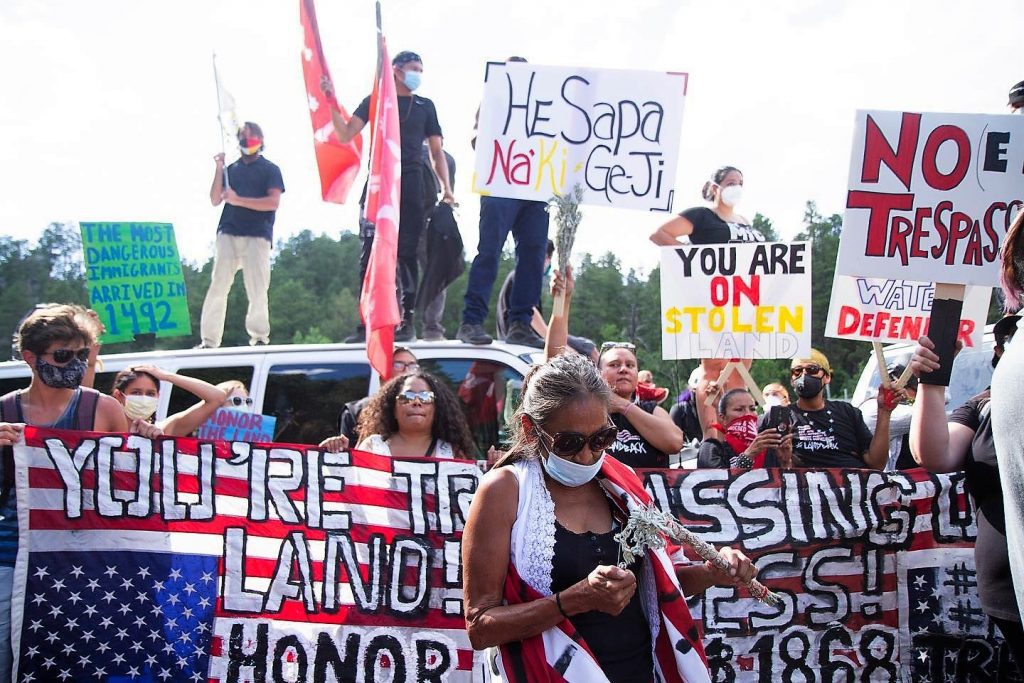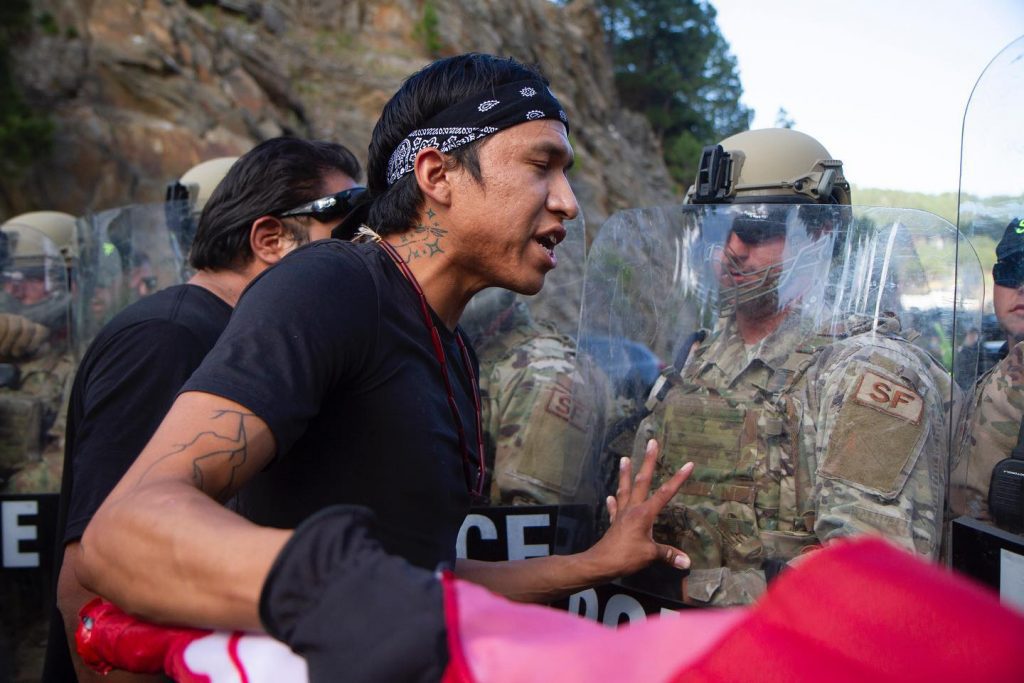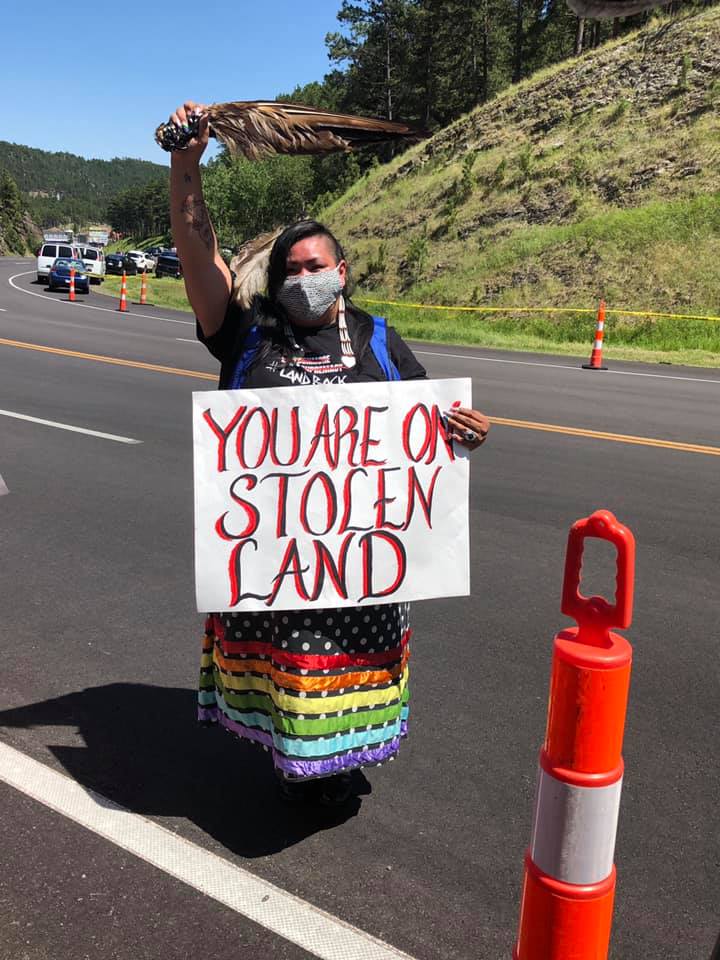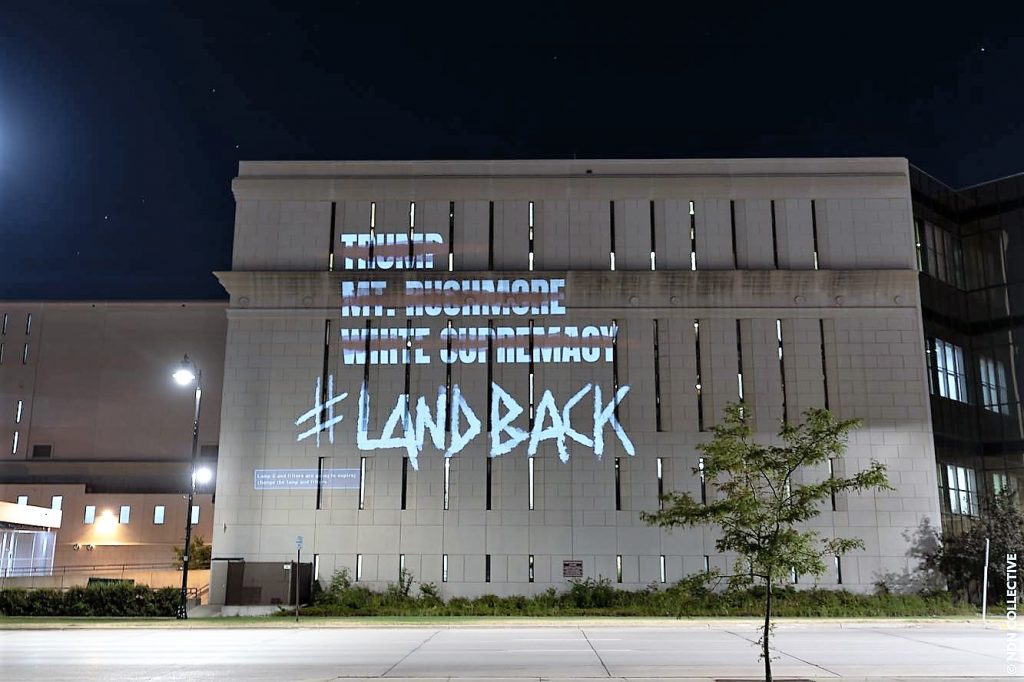
KEYSTONE, South Dakota – U.S. President Donald Trump’s reelection campaign-stop here at Mt. Rushmore National Memorial on the eve of the national Independence Day holiday provoked a rally of some 400 Native Americans and allies, who seized the opportunity to remind him he was trespassing on sacred Black Hills Indian treaty land stolen in violation of the Constitution.
“What do we want? Land back. When do we want it? Now!” was the prevailing chant of the multitude.
It succeeded in drawing worldwide attention to the cause by blocking an access route to the memorial, delaying some of the more than 7,000 Trump campaign supporters who had paid to attend the July 3 private event at the public venue.
“Mount Rushmore is on stolen Lakota land and its very existence is a symbol of white supremacy,” said Nick Tilsen, president and CEO of the Rapid City-based national non-profit NDN Collective, which initiated the action.
“In opposing the ongoing desecration of our sacred land and asking for return of Lakota lands where Mount Rushmore is situated, we’re not saying anything that our parents, grandparents and great grandparents haven’t already said,” Tilsen noted.

With a classic show of civil disobedience, demonstrators disabled tires on several late-model white vans parked across all four lanes of the blacktop highway connecting the town of Keystone to the national park visitors center, then stood by, singing, shouting and waving banners, as well as an Oglala Sioux tribal nation flag, for four hours until law enforcement mobilized to suppress the action.
Helicopters repeated flyovers as Pennington County Sheriff’s deputies, South Dakota Highway Patrol, Homeland Security, National Guard, U.S. Secret Service, USDA Forest Service, park rangers, police in riot gear, and other armed personnel joined forces to tow the vans, clear the roadblock, and arrest dissidents.
Covering the activity for independent Pine Ridge Indian Reservation Radio KILI, Arlo Iron Cloud reported shots fired toward the feet of rally participants. Law enforcement insisted he leave his hillside observation post and move to the highway area surrounded by weaponized professionals, even when he objected that he was working media.
Tensions rose as patrol members donned gas masks. No tear gas discharges were verified but some of the unarmed demonstrators were sprayed with mace, according to legal observers. “Every conflict was police-initiated,” said legal observer Bruce Ellison, an attorney on NDN Collective’s legal team.
The team’s conversations with sheriff and other local officers in advance of the direct action aimed to assure law enforcement that no use of force would be necessary as plans were for peaceful assembly; if outside armed reinforcements had not arrived, the road would have been cleared in half the time, Ellison observed.
“Some of the over-reaction we were seeing was just a tip-off for the Keystone XL Pipeline,” he said, referring to fears that the state will repress civil rights of native oil pipeline fighters, such as Tilsen, if building continues.

Arrested and jailed for protecting their own land
Eventually, from somewhere near one of several formations of camouflage-suited and shield-carrying troopers, a loudspeaker announcement warned four times, “This is an unlawful assembly. Disperse immediately.” Verbal retorts ensued: “You are unlawful. Why don’t you disperse?”
After many demonstrators avoided arrest by clearing out, ranks of uniformed agents advanced on the remaining targets and zip-tied their hands behind their backs, taking them into custody — all to taunts of “You stole this land,” but no resistance.
A transport van escorted at least a dozen detainees from there to the Pennington County office complex for booking and jail. They were released on July 4, except for Tilsen, who was held until his bond hearing July 6.
Tilsen was released on $2,000 cash bond to face criminal charges of second-degree robbery, which carries a maximum 10-year prison sentence, and simple assault of a law enforcement officer, which carries a maximum two-year sentence.
He also faces misdemeanor charges of unlawful assembly and impeding traffic, which have one-year maximum jail penalties, as well as a petty misdemeanor charge of disorderly conduct, with a maximum 30-day sentence.
Tilsen is an outspoken opponent of oil pipeline construction through unceded 1851 and 1868 Ft. Laramie Treaty territory, which includes the Black Hills.
The U.S. Supreme Court In 1980 awarded $105 million to the tribes of the Great Sioux Nation for the theft of the Black Hills and other lands guaranteed under the 1868 treaty, which had promised the Oceti Sakowin, or Seven Council Fires, “the absolute and undisturbed use and occupation of the Great Sioux Reservation.”
“A more ripe and rank case of dishonest dealing may never be found in our history,” Supreme Court Justice Harry Blackmun said in his opinion of the U.S. failure to enforce the treaty language as required by the U.S. Constitution.
Three decades later, the interest on the money in the U.S. Treasury has brought the offer to upwards of $1.4 billion. However, insisting that “the Black Hills are not for sale,” the Sioux Nation tribes refuse to accept a payout and have lobbied for a settlement to return them the portion of the Black Hills that is under federal management.

Governor invites President without tribal approval
South Dakota Gov. Kristi Noem invited Trump to hold the campaign event here on the eve of the national Independence Day annual celebration. Ellsworth Airforce Base provided a Blue Angels fighter jet air show at the occasion. Fireworks over the mountain carving of four presidents capped the incumbent candidate’s discourse.
Trump launched the speech, thanking Noem and saying, “There could be no better place to celebrate America’s independence than beneath this magnificent, incredible, majestic mountain and monument to the greatest Americans who have ever lived.”
His speech neglected to mention the descendants of the original inhabitants here and only once mentioned the coronavirus pandemic, which logged a record number of cases nationwide that day.
“Let us also send our deepest thanks to our wonderful veterans, law enforcement, first responders and the doctors, nurses and scientists working tirelessly to kill the virus,” he said.
Tribal leaders irate over failure to require health safety protocols
Noem declared in advance that no protocols would be in force on this occasion to protect from spread of the pandemic, despite Trump’s recent exposure to a staffer tested positive for the uncontrolled lethal virus at an Oklahoma campaign-stop during the outbreak’s June surge there.
With cases at their U.S. peak, the deliberate absence of requirements for masking, distancing, and other public safety measures at a national gathering drew harsh criticism from South Dakota tribal government leaders.
“It’s incredible that this Administration is playing with our lives for a photo-op,” said Cheyenne River Sioux Tribal Chair Harold Frazier, “especially after members of the President’s own advance team and Secret Service tested positive following his irresponsible Tulsa rally.”
Frazier joined Oglala Sioux Tribal Chair Julian Bear Runner and Rosebud Sioux Tribal Chair Rodney Bordeaux in denouncing the Trump Administration’s “retaliatory measures” against the tribes for posting coronavirus health checkpoints along reservation roads.

Attempts to erode tribal sovereignty precede event
Frazier has sued Trump for threats to tribal sovereignty in the recent U.S. Interior Department’s response to Noem’s plea for help to close down the roadside stations.
“Now he’s hosting an over-the-top fireworks display in our sacred Black Hills, while he doles out retribution against our tribal governments,” Frazier said. “And for what? For doing what he failed to do—protecting people from a deadly virus.”
Interior and its BIA administrators said they would pull pandemic relief funding and a law enforcement contract support if the Cheyenne River Sioux Tribe doesn’t do Noem’s bidding.
Monument besmirches sacred mountain
The Shrine of Democracy, as it is often called, is named after New York City attorney Charles E. Rushmore, who was verifying property titles in 1884 when he asked local guide Bill Challis the name of this mountain. Challis replied, “Never had a name but from now on we’ll call it Rushmore,” according to the non-profit publication National Parks Traveler.
However, what came to be known as Mt. Rushmore National Memorial was once called Tȟuŋkášila Šákpe, the name in the Lakota language for The Six Grandfathers. “The granite bluff that towered above the Hills remained carved only by the wind and the rain until 1927 when Gutzon Borglum began his assault on the mountain.”
So goes the oral history, as captured by the Chamberlain-based non-profit Native Hope, which advocates to reverse “injustice done to Native Americans.” One of its main tools is storytelling – to dismantle barriers and promote healing.
Lakota holy man Nicolas Black Elk named The Six Grandfathers after a vision “of the six sacred directions: west, east, north, south, above, and below. The directions were said to represent kindness and love, full of years and wisdom, like human grandfathers,” Native Hope documents.
Borglum, fresh from sculpting the massive Confederate Memorial bas relief at Stone Mountain in Georgia, answered the call of Black Hills tourism industry promoters to create a sculpture on this granite outcrop “to honor the West’s greatest heroes, both Native Americans and pioneers.”
However, Borglum had his own kind of vision and convinced backers to let him carve the busts of U.S. President George Washington alongside White House successors Thomas Jefferson, Theodore Roosevelt, and Abraham Lincoln.
At U.S. President Donald Trump’s July 3 reelection campaign-stop here, he received applause for saying, “Today, we pay tribute to the exceptional lives and extraordinary legacies of George Washington, Thomas Jefferson, Abraham Lincoln, and Teddy Roosevelt.”

Trump likens equal rights movement to street fight over symbols
He took advantage of the backdrop to fan the flames of national controversy over racist symbols in public art, part of unrest ignited a month earlier with the death of Black Minneapolis resident George Floyd under the knee of a white officer, which was proclaimed murder by the police chief.
“Our nation is witnessing a merciless campaign to wipe out our history, defame our heroes, erase our values, and indoctrinate our children,” Trump said. “Angry mobs are trying to tear down statues of our founders, deface our most sacred memorials, and unleash a wave of violent crime in our cities.”
He received more applause for saying, “I am here as your President to proclaim before the country and before the world: This monument will never be desecrated, these heroes will never be defaced, their legacy will never, ever be destroyed, their achievements will never be forgotten, and Mt. Rushmore will stand forever as an eternal tribute to our forefathers and to our freedom.”
Less than 80 years since the completion of the mountain carving, more than one participant in the civil disobedience demonstration triggered by the campaign stop here recast it as the Shrine of Hypocrisy.

Critics blast Shrine of Hypocrisy
Cheyenne River Sioux Tribal Chair Harold Frazier objected strenuously to the campaign stop at the monument, saying, “Nothing stands as a greater reminder to the Great Sioux Nation of a country that cannot keep a promise or treaty then the faces carved into our sacred land on what the United States calls Mount Rushmore.”
He criticized a waiver of the fireworks ban allowing the campaign event to have a show in the Black Hills during fire danger season. “We are now being forced to witness the lashing of our land with pomp, arrogance and fire hoping our sacred lands will survive,” he said.
“Visitors look upon the faces of those presidents and extol the virtues that they believe make America the country it is today. Lakota see the faces of the men who lied, cheated and murdered innocent people whose only crime was living on the land they wanted to steal,” he insisted.
Washington and Jefferson owned slaves. Jefferson said: “If ever we are constrained to lift the hatchet against any tribe, we will never lay it down till that tribe is exterminated or driven beyond the Mississippi. In war they will kill some of us; we shall destroy them all.”
Roosevelt borrowed the phrase “the only good Indian is a dead Indian,” modifying it to say only nine out of 10 fit into that category. Lincoln, on the day after he signed the Emancipation Proclamation, ordered the largest mass execution in U.S. history, with the public hanging of 38 Dakota sons.
Borglum was “once high in the inner circle of the Klan,” writes author Charles Rambow in the South Dakota State Historical Society’s 1973 publication The Ku Klux Klan in the 1920s: A Concentration on the Black Hills.
Trump whistle-stop adds insult to injury
Days before Trump’s campaign stop, both Frazier and Oglala Sioux Tribal President Julian Bear Runner had publicly advocated for “removal” of the landmark.
A 19th century gold discovery attracted thousands of squatters to the Black Hills, and the U.S. government broke its constitutional mandate to uphold the treaty protecting the area for the Oceti Sakowin. The effigies on a sacred mountain were seen as a desperate thrust of a failed conquest.
“For the Lakota, this was just one more violating act of colonization,” Native Hope relates.
“The Lakota have opposed Mount Rushmore since the very beginning,” said Nick Tilsen, leader of the civil disobedience action at the Trump stopover.
Tilsen’s national non-profit NDN Collective called for “closure of Mount Rushmore” but was quick and determined to stress that the cause is not as superficial as a symbolic sculpture.
Rather it is “for the Black Hills to be returned to the Lakota” in redress for more than a century of illegal use of the most sacred tract of ancestral territory.
Demonstrators accused the would-be second-term chief executive with turning a blind eye to the United Nations universal principle of indigenous peoples’ right to free prior and informed consent because he chose this location without asking tribal authorization.
While the protesters’ main demand was to honor rights granted by the Constitution, which holds treaties as the highest law of the land, they also stood up for human and civil rights, bearing signs and slogans including Black Lives Matter and drawing attention to the crisis of Missing and Murdered Indigenous Women.
A version of this article appeared in the Native Sun News Today and is republished here with permission.

Black Hills Donald Trump Mount Rushmore native resistance sacred lands
There has been too much mistreatment of native Americans for many, many years. From before the small pox ! Time to stand up to fight once again for your land and freedom. Is this not “the land of the free” and the brave? Stand strong
With God at your side. Take back what once was yours. The government has robbed us all from dignity!
I’d love to share this article on my fb timeline and more than likely others. I have almost 2100 fb friends. Thank you for this reportage and keeping these dishonorable issues front and center!
We appreciate you so much, Campbell. You are the best kind of reader. Thank you for caring, and for sharing.